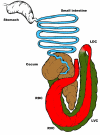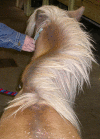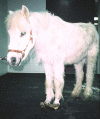Medical implications of obesity in horses--lessons for human obesity
- PMID: 20046661
- PMCID: PMC2769846
- DOI: 10.1177/193229680900300119
Medical implications of obesity in horses--lessons for human obesity
Abstract
There is growing recognition that obesity is common and represents a significant detriment to the health of companion animals in a manner similar to that by which it is affecting the human population. As is the case for other species, obesity appears to promote insulin resistance in horses and it is through this pathophysiological process that many of the adverse medical consequences of obesity are being characterized. Equine medical conditions that have been described in the context of obesity and insulin resistance differ from those in humans. Chronic human conditions that have been attributed to obesity and insulin resistance, such as atherosclerosis and diabetes mellitus, are rarely described in obese horses. Significant current interest is centered on the recognition that insulin resistance plays a role in the pathogenesis of laminitis, a potentially severe and debilitating cause of lameness in the equine species. Other equine medical conditions that are more likely in obese, insulin-resistant individuals include hyperlipemia (hepatic lipidosis) and developmental orthopedic disease (osteochondrosis). Pituitary pars intermedia dysfunction (equine Cushing's syndrome) represents another common endocrinopathic condition of older horses associated with insulin resistance. This review presents an introductory overview of the present understanding of obesity and insulin resistance and how these conditions may be associated with disease conditions in horses.
Keywords: Cushing's; horse; insulin resistance; laminitis; nutrition; obesity; pituitary gland.
© Diabetes Technology Society
Figures








Similar articles
-
Diabetes, insulin resistance, and metabolic syndrome in horses.J Diabetes Sci Technol. 2012 May 1;6(3):534-40. doi: 10.1177/193229681200600307. J Diabetes Sci Technol. 2012. PMID: 22768883 Free PMC article. Review.
-
The equine metabolic syndrome peripheral Cushing's syndrome.Vet Clin North Am Equine Pract. 2002 Aug;18(2):271-93. doi: 10.1016/s0749-0739(02)00006-8. Vet Clin North Am Equine Pract. 2002. PMID: 15635908 Review.
-
From Table to Stable: A Comparative Review of Selected Aspects of Human and Equine Metabolic Syndrome.J Equine Vet Sci. 2019 Aug;79:131-138. doi: 10.1016/j.jevs.2019.06.003. Epub 2019 Jun 20. J Equine Vet Sci. 2019. PMID: 31405493 Review.
-
Genomewide association study reveals a risk locus for equine metabolic syndrome in the Arabian horse.J Anim Sci. 2017 Mar;95(3):1071-1079. doi: 10.2527/jas.2016.1221. J Anim Sci. 2017. PMID: 28380523
-
Cushing's syndromes, insulin resistance and endocrinopathic laminitis.Equine Vet J. 2004 Apr;36(3):194-8. doi: 10.2746/0425164044877279. Equine Vet J. 2004. PMID: 15147123 No abstract available.
Cited by
-
Diabetes, insulin resistance, and metabolic syndrome in horses.J Diabetes Sci Technol. 2012 May 1;6(3):534-40. doi: 10.1177/193229681200600307. J Diabetes Sci Technol. 2012. PMID: 22768883 Free PMC article. Review.
-
Serum metabolomic analysis of the dose-response effect of dietary choline in overweight male cats fed at maintenance energy requirements.PLoS One. 2023 Jan 23;18(1):e0280734. doi: 10.1371/journal.pone.0280734. eCollection 2023. PLoS One. 2023. PMID: 36689425 Free PMC article.
-
RNA sequencing as a powerful tool in searching for genes influencing health and performance traits of horses.J Appl Genet. 2016 May;57(2):199-206. doi: 10.1007/s13353-015-0320-7. Epub 2015 Oct 7. J Appl Genet. 2016. PMID: 26446669 Review.
-
Correlation of fecal microbiome dysregulation to synovial transcriptome in an equine model of obesity associated osteoarthritis.Ann Transl Med. 2024 Dec 24;12(6):112. doi: 10.21037/atm-24-109. Epub 2024 Dec 13. Ann Transl Med. 2024. PMID: 39817240 Free PMC article.
-
The Differences in Histoarchitecture of Hoof Lamellae between Obese and Lean Draft Horses.Animals (Basel). 2022 Jul 11;12(14):1774. doi: 10.3390/ani12141774. Animals (Basel). 2022. PMID: 35883323 Free PMC article.
References
-
- Wyse CA, McNie KA, Tannahil VJ, Murray JK, Love S. Prevalence of obesity in riding horses in Scotland. Vet Rec. 2008;162(18):590–591. - PubMed
-
- Frank N, Elliott SB, Boston RC. Effects of long-term oral administration of levothyroxine sodium on glucose dynamics in healthy adult horses. Am J Vet Res. 2008;69(1):76–81. - PubMed
-
- Pratt SE, Geor RJ, McCutcheon LJ. Effects of dietary energy source and physical conditioning on insulin sensitivity and glucose tolerance in standardbred horses. Equine Vet J Suppl. 2006;(36):579–584. - PubMed
-
- Johnson PJ, Ganjam VK, Messer NT, Turk JR, Keisler DH, Buff PR, Wiedmeyer CE. Proceedings of the 52nd Annual Convention of the American Association of Equine Practitioners. 2-6. TX: San Antonio; 2006. Dec, The obesity paradigm: an introduction to the emerging discipline of adipobiology; pp. 41–50.
-
- Donaldson MT, McDonnell SM, Schanbacher BJ, Lamb SV, McFarlane D, Beech J. Variation in plasma adrenocorticotropic hormone concentration and dexamethasone suppression test results with season, age, and sex in healthy ponies and horses. J Vet Intern Med. 2005;19(2):217–222. - PubMed
Publication types
MeSH terms
LinkOut - more resources
Full Text Sources
Other Literature Sources
Medical
Research Materials
Miscellaneous

